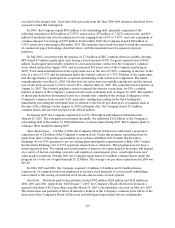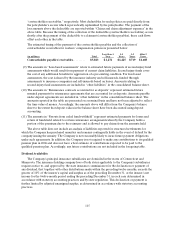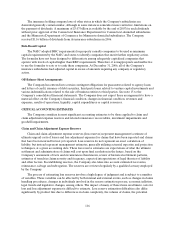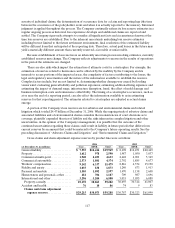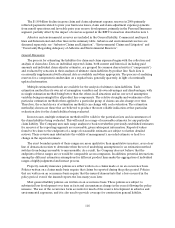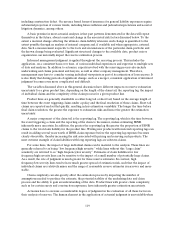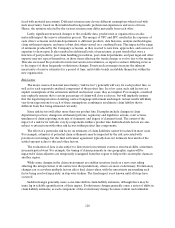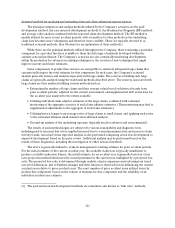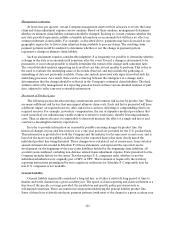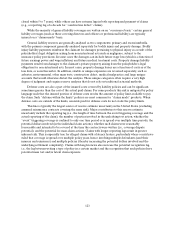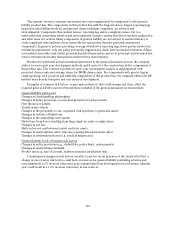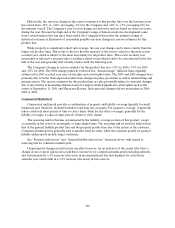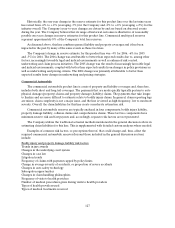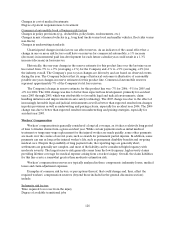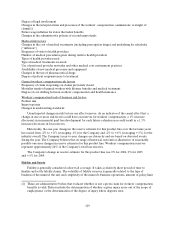Travelers 2006 Annual Report Download - page 131
Download and view the complete annual report
Please find page 131 of the 2006 Travelers annual report below. You can navigate through the pages in the report by either clicking on the pages listed below, or by using the keyword search tool below to find specific information within the annual report.119
including construction defect. Occurrence based forms of insurance for general liability exposures require
substantial projection of various trends, including future inflation and judicial interpretations and societal
litigation dynamics, among others.
A basic premise in most actuarial analyses is that past patterns demonstrated in the data will repeat
themselves in the future, absent a material change in the associated risk factors discussed below. To the
extent a material change affecting the ultimate claim liability is known, such change is quantified to the
extent possible through an analysis of internal company and, if available and when appropriate, external
data. Such a measurement is specific to the facts and circumstances of the particular claim portfolio and
the known change being evaluated. Significant structural changes to the available data, product mix or
organization can materially impact the reserve estimation process.
Informed management judgment is applied throughout the reserving process. This includes the
application, on a consistent basis over time, of various individual experiences andexpertise to multiple sets
of data and analyses. In addition to actuaries, experts involved with the reserving process also include
underwriting and claims personnel and lawyers, as wellas other company management. Therefore,
management may have to consider varying individual viewpoints as part of its estimation of loss reserves. It
is also likely that during periods of significant change, such as a merger, consistent application of informed
judgment becomes even more complicated and difficult.
The variables discussed above in this general discussion have different impacts on reserve estimation
uncertainty for a given product line, depending on the length of the claim tail, the reporting lag, the impact
of individual claims and the complexity of the claim process for a given product line.
Product lines are generally classifiable as either long tail or short tail, based on the average length of
time between the event triggering claims under a policy and the final resolution of those claims. Shorttail
claims are reported and settled quickly, resulting in less estimation variability. The longer the time before
final claim resolution, the greater the exposure to estimation risks and hence the greater the estimation
uncertainty.
A major component of the claim tail is the reporting lag. The reporting lag, which is the time between
the event triggering a claim and the reporting of the claim to the insurer, makes estimating IBNR
inherently more uncertain. In addition, the greater the reporting lag the greater the proportion of IBNR
claims to the total claim liability for the product line. Writing new products with material reporting lags can
result in adding several years worth of IBNR claim exposure before the reporting lag exposure becomes
clearly observable, thereby increasing the risk associated with pricing and reserving such products. The
most extremeexample of claim liabilities with long reporting lags are asbestos claims.
For some lines, the impact of large individual claims can be material to the analysis. These lines are
generally referred to as being “low frequency/high severity,” while lines without this “large claim”
sensitivity are referred to as “high frequency/low severity”. Estimates of claim liabilities for low
frequency/high severity lines can be sensitive to the impact of a small number of potentially large claims.
As a result, the role of judgment is muchgreater for these reserve estimates. In contrast, high
frequency/low severity lines tend to have much greater spread of estimation risk, such that the impact of
individual claims are relatively minor and the range of reasonable reserve estimates is narrower and more
stable.
Claim complexity can also greatly affect theestimation process by impacting the number of
assumptions needed to produce the estimate, the potential stability of the underlying data and claim
process and the ability to gain an understanding of the data. Product lines with greater claim complexity,
such as for certain surety and construction exposures, have inherently greater estimation uncertainty.
Actuaries have toexercise a considerable degree of judgment in the evaluation of all these factors in
their analysis of reserves. The humanelement in the application of actuarial judgmentis unavoidable when



